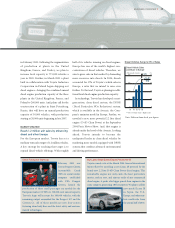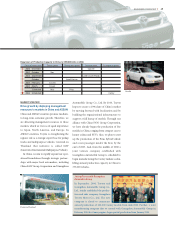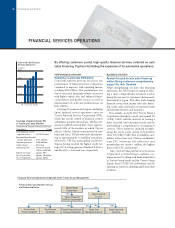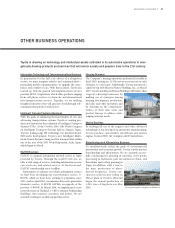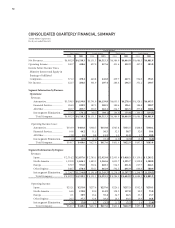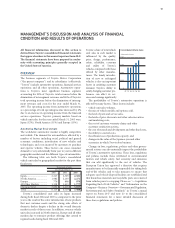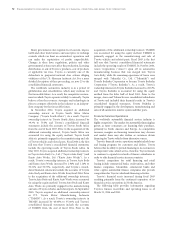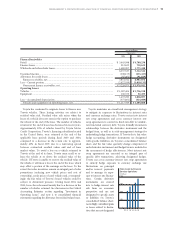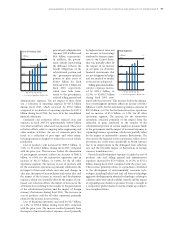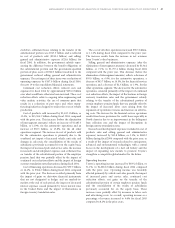Toyota 2005 Annual Report Download - page 54
Download and view the complete annual report
Please find page 54 of the 2005 Toyota annual report below. You can navigate through the pages in the report by either clicking on the pages listed below, or by using the keyword search tool below to find specific information within the annual report.
52 >MANAGEMENT’S DISCUSSION AND ANALYSIS OF FINANCIAL CONDITION AND RESULTS OF OPERATIONS
Many governments also regulate local content, impose
tariffs and other trade barriers, and enact price or exchange
controls which can limit an automaker’s operations and
can make the repatriation of profits unpredictable.
Changes in these laws, regulations, policies and other
governmental actions may affect the production, licensing,
distribution or sale of Toyota’s products, cost of products
or applicable tax rates. Toyota is currently one of the
defendants in purported national class actions alleging
violations of the U.S. Sherman Antitrust Act. For a more
detailed description of these proceeding, see note 23 to the
consolidated financial statements.
The worldwide automotive industry is in a period of
globalization and consolidation, which may continue for
the foreseeable future. As a result, the competitive environ-
ment in which Toyota operates is likely to intensify. Toyota
believes it has the resources, strategies and technologies in
place to compete effectively in the industry as an indepen-
dent company for the foreseeable future.
In November 2002, Toyota acquired an additional
ownership interest in Toyota South Africa Motor
Company (“Toyota South Africa”). As a result, Toyota’s
ownership interest in Toyota South Africa increased by
39.3% to 75.0% and Toyota’s consolidated financial
statements include the accounts of Toyota South Africa
from the end of fiscal 2003. Prior to the acquisition of the
additional ownership interest, Toyota South Africa was
accounted for using the equity method. Toyota South
Africa is primarily engaged in the manufacturing and sale
of Toyota vehicles and related parts. Fiscal 2004 is the first
full year that Toyota’s consolidated financial statements
include the operating results of Toyota South Africa. In
May 2003, Toyota acquired additional ownership interests
in Toyota Auto Body Co., Ltd. (“Toyota Auto Body”) and
Kanto Auto Works, Ltd (“Kanto Auto Works”). As a
result, Toyota’s ownership interests in Toyota Auto Body
and Kanto Auto Works increased by 2.94% and 1.14% to
50.21% and 50.57%, respectively, and Toyota’s consoli-
dated financial statements include the accounts of Toyota
Auto Body and Kanto Auto Works from fiscal 2004. Prior
to the acquisition of the additional ownership interests,
Toyota Auto Body and Kanto Auto Works were accounted
for using the equity method. Toyota Auto Body and Kanto
Auto Works are primarily engaged in the manufacturing
and sale of Toyota vehicles and related parts. In September
2003, Toyota acquired an additional ownership interest
in P.T. Toyota Motor Manufacturing Indonesia
(“TMMIN”). As a result, Toyota’s ownership interests in
TMMIN increased by 46.00% to 95.00% and Toyota’s
consolidated financial statements include the accounts
of TMMIN from the end of fiscal 2004. Prior to the
acquisition of the additional ownership interest, TMMIN
was accounted for using the equity method. TMMIN is
primarily engaged in the manufacturing and sale of
Toyota vehicles and related parts. Fiscal 2005 is the first
full year that Toyota’s consolidated financial statements
include the operating results of TMMIN. In October 2004,
Araco Corporation (“Araco”) spun off its automotive
manufacturing business that was merged into Toyota
Auto Body, while the remaining operations of Araco were
merged with Takanichi Co., Ltd. (“Takanichi”) and
Toyoda Boshoku Corporation to become Toyota Boshoku
Corporation (“Toyota Boshoku”). As a result, Toyota’s
ownership interests in Toyota Boshoku increased to 49.63%
and Toyota Boshoku is accounted for using the equity
method from the latter half of fiscal 2005. Prior to the
merger, Araco and Takanichi were consolidated subsidiaries
of Toyota and included their financial results in Toyota’s
consolidated financial statements. Toyota Boshoku is
primarily engaged in the development, manufacturing and
sales of all automotive interior system and filter parts.
Financial Services Operations
The worldwide automobile financial services industry is
highly competitive. The market for automobile financing has
grown as more consumers are financing their purchases,
primarily in North America and Europe. As competition
increases, margins on financing transactions may decrease
and market share may also decline as customers obtain
financing for Toyota vehicles from alternative sources.
Toyota’s financial services operations mainly include loans
and leasing programs for customers and dealers. Toyota
believes that its ability to provide financing to its customers is
an important value added service, therefore Toyota intends
to continue to expand its network of finance subsidiaries in
order to offer financial services in more countries.
Toyota’s competitors for retail financing and retail
leasing include commercial banks, credit unions, and other
finance companies. Meanwhile, commercial banks and
other captive automobile finance companies also provide
competition for Toyota’s wholesale financing activities.
Toyota’s financial assets increased during fiscal 2005
resulting primarily from the continued expansion of its
financial services operations in North America.
The following table provides information regarding
Toyota’s finance receivables and operating leases as of
March 31, 2004 and 2005.



